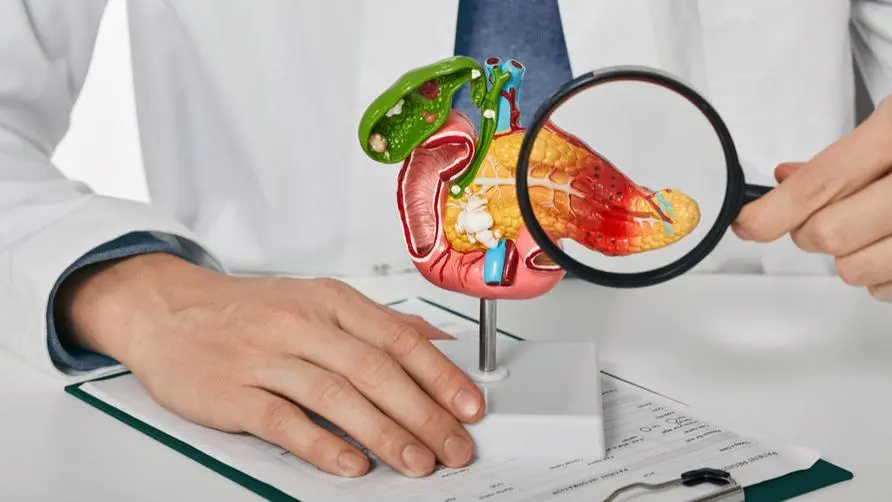More troublesome than fatty liver? "Fatty pancreas" affects the three major organs of liver, pancreas and heart. Medical education "1 thing" to help prevent it

More troublesome than “fatty liver”? The prevalence of “fatty pancreas” in Taiwan is estimated to be over 30%
Modern people’s health awareness has increased, and they are well aware that visceral fat can cause many health problems. In addition to the well-known “fatty liver”, there is also the problem of “fatty pancreas” that cannot be ignored. Dr. Yang Jianhua, director of the Ultrasound Department of Lian’an Clinic, said that fatty pancreas has been the focus of the medical community in recent years and is highly related to metabolic syndrome. Once you suffer from fatty pancreas, the risk of diabetes and cardiovascular disease may also increase in the future.
Dr. Yang Jianhua pointed out that the reason for the formation of fatty pancreas is similar to that of fatty liver. Simply put, when the human body takes in too many calories, it stores excess fat. It should be accumulated in fat cells, but the fat escapes to places outside the cells, such as the liver. It will be called “ectopic fat”. The liver is the “warehouse” among internal organs and is also where fat easily accumulates, but fat accumulation can also occur in the pancreas.
With the advancement of ultrasound equipment, the chance of discovering fatty pancreas has increased. Therefore, in the past 7-8 years, the medical community has begun to pay attention to the health issue of fatty pancreas. Research data from the National Taiwan University Health Screening Center shows that the prevalence rate of fatty pancreas in the health screening population is about 16%. However, since most of the health screening population is more health-conscious or younger, it is estimated that the true prevalence rate of fatty pancreas may be as high as 30%, and The proportion of fatty liver is similar.
It is related to liver, heart and pancreas health! Fat pancreas may be a precursor to “metabolic syndrome”
Dr. Yang Jianhua said that the scary thing about visceral fat is that it does not produce obvious symptoms immediately, but it affects the body bit by bit in life. Data show that 70% of patients with fatty liver also suffer from fatty pancreas, and up to 97% of patients with fatty pancreas suffer from fatty liver. When fatty pancreas appears, beware of the silent visit of “Metabolic Syndrome”.
Metabolic syndrome is defined as abnormalities in 3 out of 5 items including body mass index (BMI), waist circumference, blood sugar, blood lipids, and blood pressure. The detailed definition is as follows:
Waist circumference: men ≧90cm, women ≧80cm
Blood pressure: systolic blood pressure ≧130mm or diastolic blood pressure ≧85mm, or you are taking antihypertensive drugs.
Fasting blood sugar: Fasting blood sugar value ≧100mg/dL, or you are taking medication to treat diabetes.
Fasting triglyceride: triglyceride ≧150mg/L, or you are taking triglyceride-lowering drugs.
High-density lipoprotein cholesterol: <40mg/dL for men and <50mg/dL for women.
Dr. Yang Jianhua said. Many studies have confirmed that fatty pancreas is positively related to many chronic diseases, such as cardiovascular disease, diabetes, fatty liver, pancreatic inflammation, etc., and fatty pancreas tends to occur in the elderly. As age increases, the amount of fat in the pancreas decreases. Infiltration is more obvious, especially in male friends. Therefore, fatty pancreas is only a symptom that appears earlier than the above values, and the public is reminded to pay more attention.
Fatty pancreas is accompanied by high risk of diabetes. Doctor’s appeal: Do “one thing” to effectively prevent it
Dr. Yang Jianhua pointed out that when the fat accumulation in the pancreas exceeds 5%, pancreatic cells will begin to be damaged, and fat infiltration will damage pancreatic beta cells, resulting in reduced insulin secretion; and when fat accumulation increases, insulin sensitivity worsens. , the risk of diabetes is also higher. Foreign studies have also found that 50% of patients with fatty pancreas are prone to diabetes, and 60-70% of diabetic patients also have fatty pancreas. Therefore, we would like to remind you that if you have a fatty pancreas during a health check-up, you need to pay more attention to the signs of “early diabetes”, such as abnormal blood sugar.
Dr. Yang Jianhua explained that if you want to avoid lipogenesis or eliminate visceral fat, the most important policy is still “diet control”, and it is more effective than exercise. For example, reduce the intake of refined sugar and refined starch and eat more original foods. In addition, you should pay attention to the intake of fructose, because fructose can only be catabolized in the liver and is often easily stored in the internal organs. Since obese people are the main high-risk group for fatty pancreas, moderate weight loss is recommended, which can help improve many metabolic problems.
People with a history of diabetes, triglycerides, and metabolic syndrome are also at risk for fatty pancreatic hyperplasia. It is recommended to undergo regular abdominal ultrasound examinations. However, abdominal ultrasound is still limited by the location of the pancreas in the retroperitoneal cavity, so sometimes the detection cannot be comprehensive. MRI, endoscopic ultrasound, and computed tomography can all provide more accurate examinations, but they are relatively expensive and cannot be widely used. Implementation.
Finally, Dr. Yang Jianhua appeals to the public. Once they discover that they may have fatty pancreas, it is recommended to track changes in blood sugar, blood pressure, and blood lipids every 3-6 months, control metabolic syndrome-related indicators as early as possible, and reduce the accumulation of triglycerides. Take good care of your pancreatic health. In addition, it is recommended to maintain good eating habits and lifestyle, coupled with appropriate exercise, to help maintain good pancreatic health.
Further reading:





